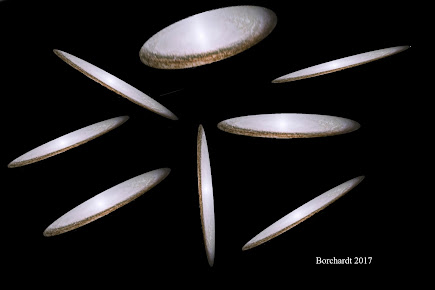PSI Blog 20210628 Cause of the motion of aether particles
This week’s book prize goes
once again to Abhishek Chakravartty for another good question:
“You wrote that per the
Second Law of Thermodynamics, the entropy of each wave would be less than the previous.
Some of the motion of the particles would be lost to the environment which, in
the case of light, must consist of progenitor aether-2 particles magnitudes
smaller than the aether-1 particles directly responsible for light
transmission. Can you explain how the motion of aether-1 particles consists of
aether-2 particles?”
[GB: Abhi, in Infinite
Universe Theory all things are assumed to consist of other things ad infinitum.
For this assumption to work, scale is irrelevant. In “Universal Cycle Theory”[1]
Steve and I speculated that, while baryonic (ordinary) matter is formed from
aether particles, the hierarchical nature of the Infinite Universe requires
even smaller microcosms to form the constituents of aether. Aether would be a
benefactor of an infinite series. For that discussion we renamed “aether” as aether-1,
with it having formed from aether-2, which had to be formed from aether-3, and
so on… That is a corollary from the Tenth Assumption of Science, interconnection
(All things are interconnected, that is, between any two objects exist other
objects that transmit matter and motion). Note that aether-2, like all the
other intervening microcosms, provides little resistance to the motion of
larger microcosms in the infinite hierarchy, often giving “support” to the
perfectly empty space assumption of Einstein’s Untired Light Theory and the Big
Bang Theory.
Later,[2] I
realized that aether particles probably were vortices because: 1) the formation
of matter requires vortex motion, which develops when constituents vary in size
per relativism
(Figure), 2) vortices are common throughout the Infinite Universe at all
scales, 3) vortex structure would result in the T-waves that dominate light
motion.
“Hypothetical aether
particles showing the effects of vortex morphology” (Borchardt, 2017, figure
49).
Not shown in the figure are
the aether-2 particles, which like the aether-1 particles, cannot be seen by us
baryonically formed microcosms. I imagine the aether-2 particles form from
aether-3 particles in the same way baryonic matter forms from aether-1
particles. Each of these vortices accretes their constituents in the same way
the solar system and the Milky Way does. Per the Sixth Assumption of
Science, complementarity (All things are subject to divergence and
convergence from other things) these eventually will dissipate like all other
microcosms, to be replaced by new ones formed in similar ways. Note that no one
has proposed a “structure” for Einstein’s imaginary photons aside from the
wave-particle oxymoron. Photons are massless and thus can have no constituents.
Remember that the impacts attributed to photons (e.g., the photoelectric
effect) must be due to local aether particles in the same way local nitrogen
molecules impact your ear drums.
The motions of the submicrocosms (constituents) within a
microcosm serve to preserve its structure. For instance, without the impacts of
the helium atoms on the insides of the balloon it could not exist as an
inflated balloon.
In Infinite Universe Theory the motion of aether-1particles
does not result from its containing aether-2 particles. The motion of a
particular microcosm is primarily the result of impacts from other microcosms
per “univironmental determinism” (what happens to a portion of the universe
depends on the infinite matter within and without). For instance, the motion of
a helium balloon depends on the macrocosm (environment) in which it exists. In
the atmosphere, the pressure beneath it is greater than above it. The impacts
from nitrogen molecules beneath it are more numerous and more active than those
above it. Note there is no religious “first cause” because there is always yet
another microcosm in the Infinite Universe to do the job. The
opposing finity assumption is the religious foundation of the
ever-popular Big Bang Theory, which is the last gasp of creationism.]
[1] Puetz,
S.J., and Borchardt, Glenn, 2011, Universal Cycle Theory: Neomechanics of the
Hierarchically Infinite Universe: Denver, Outskirts Press,
626 p. [https://go.glennborchardt.com/UCT].
[2] Borchardt,
Glenn, 2017, Infinite Universe Theory: Berkeley, California, Progressive
Science Institute, 337 p. [http://go.glennborchardt.com/IUTebook].



